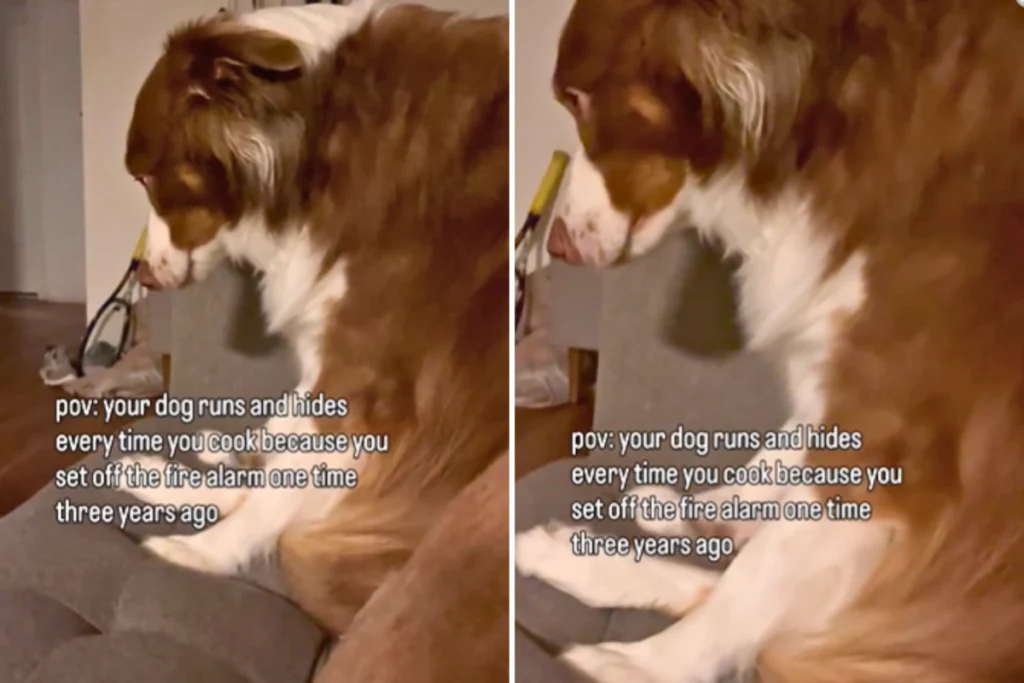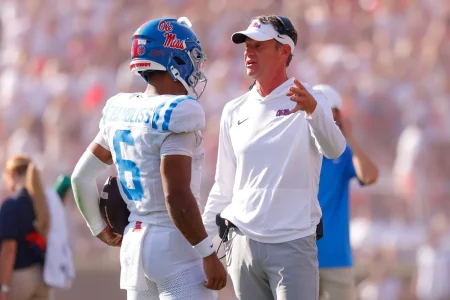Bonzai’s Kitchen Anxiety: A Canine Memory That Won’t Fade
In the world of domestic dogs, few things are as enticing as the sound of food sizzling on a stovetop. Most canines come running at the first hint of cooking aromas, tails wagging and noses twitching in anticipation. But for Bonzai, a four-year-old Australian shepherd from Tampa, Florida, the kitchen has become a place of anxiety rather than excitement. Instead of hovering hopefully near the counter, Bonzai makes a beeline for his safe space whenever someone turns on the stove. This peculiar behavior stems from a single traumatic incident that occurred three years ago but remains firmly embedded in the dog’s memory. Peyton Flowers Dunn, Bonzai’s 30-year-old owner, explains that her husband Ben inadvertently triggered the fire alarm while preparing a special birthday breakfast. “Bonzai was almost one-year-old the first time he experienced the blaring fire alarm thanks to his dad’s cooking,” Dunn recalls. “His dad was kindly making me bacon as a birthday morning surprise. Much to my dismay (and Bonzai’s), I awoke to the sound of shrill beeping.” The startled dog immediately sought refuge under the coffee table—a spot that has since become his designated comfort zone during cooking sessions.
The pattern that developed after that morning has become a predictable routine in the Dunn household. Despite Bonzai’s natural desire to be in the kitchen, especially when his keen ears detect the sound of the cheese drawer opening, the mere act of turning on the stovetop sends him scurrying to safety. “Ever since, Bonzai has chosen a place of safety instead of the kitchen as soon as the stovetop is turned on,” Dunn explains. What makes this behavior particularly interesting is its consistency and longevity. A single frightening experience from years ago continues to influence Bonzai’s behavior, demonstrating the remarkable emotional memory capabilities of dogs. Unlike humans, who might rationalize past experiences or gradually overcome fears through repeated exposure without negative consequences, Bonzai’s association between cooking and potential danger remains firmly intact. This response highlights the powerful way dogs form associations and how deeply ingrained those connections can become, especially when linked to startling sensory experiences like the piercing sound of a fire alarm.
When Dunn shared a video of Bonzai’s quirky behavior on Instagram, she couldn’t have anticipated the overwhelming response it would receive. The short clip, captioned “POV: your dog runs and hides every time you cook because you set off the fire alarm one time three years ago,” quickly went viral, amassing over 570,000 views and resonating with pet owners worldwide. The comments section filled with similar stories from other pet parents, revealing that Bonzai’s long memory isn’t unique among domestic animals. “They never forget, or let you forget,” one commenter observed, while another sympathetically noted, “He’s so traumatized.” The video seemed to unlock a collective sharing experience, as viewers eagerly recounted their own pets’ peculiar behaviors stemming from past incidents. One Instagram user described how their dog named Eowyn hides at the mere sight of someone opening the cabinet containing the toaster, fearful of the moment when the toast pops up. These shared experiences created a sense of community among pet owners, united by the endearing and sometimes puzzling ways their animals remember and respond to past events.
The comment section of Dunn’s viral post became a treasure trove of animal memory anecdotes, showcasing the remarkable capacity of pets to form lasting associations from single experiences. “Our comments are full of people sharing the strange things their pets won’t forget,” Dunn says. “There’s the dog that checks the same bush every walk because it once had a slice of pizza under it, or the cat that bolts anytime the ice machine is used after being hit on the head by falling ice.” These stories highlight an important aspect of animal cognition—the ability to form strong associative memories, particularly around experiences that trigger intense emotional responses like fear or excitement. While scientists continue to study the complexities of animal memory, pet owners have long observed these patterns in their companions. What might seem irrational to humans makes perfect sense in the animal’s experience: if something frightening happened once in a particular context, avoiding that context entirely is a logical survival strategy. The consistency of these behaviors—checking the same bush years later or fleeing from the sound of an ice machine—speaks to the durability of these associations.
For Dunn, sharing Bonzai’s story online was about more than just showcasing her dog’s quirky behavior—it was about creating a moment of joy and connection in an often divisive digital landscape. “I shared this online to show a small ‘slice of life,'” she explains. “I’ve found that social media can be so tense and divisive, but dog videos unite and make people smile.” There’s something universally appealing about animal stories that transcends the usual social media barriers, creating moments of shared delight across different demographics. Dunn understands this power firsthand, having once been on the other side of the screen herself. “Before I was able to have a dog, I lived vicariously through dog videos and grew attached to some pets of Instagram. Now, I hope I can create videos that make people happy.” In this way, Bonzai’s kitchen anxiety has been transformed from a simple household quirk into a source of connection and joy for thousands of viewers who recognize something of their own pets in his behavior.
Bonzai’s story speaks to the special bond between humans and their animal companions—a relationship built on understanding, adaptation, and acceptance of each other’s quirks. While humans might find it amusing that a dog would remember and react to a single incident from years ago, this behavior highlights the complex emotional lives of our pets. They experience the world differently than we do, forming associations and memories that shape their behaviors in ways we might not always understand but can learn to accommodate. For the Dunn family, this means accepting that cooking will always send Bonzai to his safe space, a small adjustment in their household routine that acknowledges and respects their dog’s emotional needs. As Bonzai’s viral fame demonstrates, sharing these stories does more than just entertain—it helps us recognize the rich inner lives of the animals with whom we share our homes and hearts. It’s a reminder that our pets aren’t just living alongside us but are experiencing their own complex emotional journeys, forming memories and associations that may last a lifetime, even if that lifetime began with a breakfast bacon mishap that set off a fire alarm three years ago.















